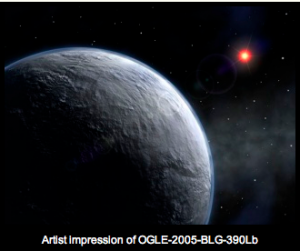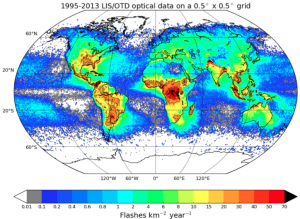Exoplanets
The Astronomy Group is furthermore part of the Centre for Exoplanet Science, which brings together researchers from different disciplines to find out how planets form in different galactic environments, how their atmospheres evolve, and the relation between the evolutionary history of planets and the emergence of life.
Detection Methods
Andrew Cameron, Martin Dominik, Keith Horne
In St Andrews, we are currently carrying out experiments for detecting extra-solar planets based on two different techniques – transits and microlensing -, while also studying debris disks around nearby stars, which constitute candidate systems for the presence of planets. Our research featured in an exhibit “Is there anybody out there? Looking for new worlds”, which was concepted for the 2008 Royal Society Summer Science Exhibition.
Transits
 Doppler surveys show that 1% of nearby main-sequence stars host “hot Jupiters” in 1-4 day orbits with radii less than 0.05 AU. 10% of those should have orbits close enough to edge-on for the planet to transit in front of the star. Transiting planets are uniquely useful because the drop in light level as the planet crosses the star gives us precise measurements of the planet’s radius. As a leading member of the UK SuperWASP project, we are conducting a wide-angle survey of bright stars for transits of large, short-period planets with two identical robotic observatories giving access to both the northern and the southern sky. Working in collaboration with the Geneva planet-search team in the southern hemisphere and the SOPHIE radial-velocity spectrometer team in the north, the SuperWASP team has discovered 60 transiting planets between 2006 September and 2011 August. We have been allocated time on the Hubble Space Telescope and the infrared Spitzer Space Telescope to make precise measurements of the sizes and atmospheric temperatures of many of these planets. Using the HARPS spectrometer on the ESO 3.6-m telescope, we have discovered that the orbits of many of these planets are strongly tilted or even retrograde relative to the stellar spin axis, providing important dynamical clues to their origins. Through SUPA-2, the University of St Andrews has contributed to the construction of the Geneva-led HARPS-North radial-velocity spectrometer, which was commissioned at the 3.5-m Telescopio Nazionale Galileo (TNG) on La Palma early in 2012. Its primary goal is to measure the masses of low-mass planet candidates discovered by the NASA Kepler mission, achieving long-term 1 metre per second median radial-velocity precision on V < 11-mag stars. Over the next five years (2017-2022) the programme will be renewed and expanded to characterise planets transiting brighter stars from the NASA TESS mission and the Swiss-led ESA CHEOPS satellite following their respective launches in 2018.
Doppler surveys show that 1% of nearby main-sequence stars host “hot Jupiters” in 1-4 day orbits with radii less than 0.05 AU. 10% of those should have orbits close enough to edge-on for the planet to transit in front of the star. Transiting planets are uniquely useful because the drop in light level as the planet crosses the star gives us precise measurements of the planet’s radius. As a leading member of the UK SuperWASP project, we are conducting a wide-angle survey of bright stars for transits of large, short-period planets with two identical robotic observatories giving access to both the northern and the southern sky. Working in collaboration with the Geneva planet-search team in the southern hemisphere and the SOPHIE radial-velocity spectrometer team in the north, the SuperWASP team has discovered 60 transiting planets between 2006 September and 2011 August. We have been allocated time on the Hubble Space Telescope and the infrared Spitzer Space Telescope to make precise measurements of the sizes and atmospheric temperatures of many of these planets. Using the HARPS spectrometer on the ESO 3.6-m telescope, we have discovered that the orbits of many of these planets are strongly tilted or even retrograde relative to the stellar spin axis, providing important dynamical clues to their origins. Through SUPA-2, the University of St Andrews has contributed to the construction of the Geneva-led HARPS-North radial-velocity spectrometer, which was commissioned at the 3.5-m Telescopio Nazionale Galileo (TNG) on La Palma early in 2012. Its primary goal is to measure the masses of low-mass planet candidates discovered by the NASA Kepler mission, achieving long-term 1 metre per second median radial-velocity precision on V < 11-mag stars. Over the next five years (2017-2022) the programme will be renewed and expanded to characterise planets transiting brighter stars from the NASA TESS mission and the Swiss-led ESA CHEOPS satellite following their respective launches in 2018.
Microlensing
At any given time, only one in a million stars in the Galactic bulge is significantly brightened due to the bending of its light caused by the gravitational field of an intervening foreground star, a phenomenon known as (galactic) gravitational microlensing. However, daily monitoring of hundreds of millions of stars by survey teams (such as OGLE or MOA) results in about 1000 on-line alerts of ongoing microlensing events per year. A planet orbiting the foreground ‘lens’ star can reveal its existence by producing a brief deviation on the observed light curve, lasting from days for a Jupiter down to hours for an Earth. Since 1997, members of our group have been involved in the PLANET (Probing Lensing Anomalies NETwork) collaboration, which was the first systematic effort to hunt for extra-solar planets by means of high-cadence round-the-clock follow-up observations on ongoing microlensing events. While PLANET used a network of staffed 1m-class optical telescopes, we pioneered the use of 2.0m robotic telescopes with RoboNet-1.0 and now RoboNet-II, as well as the deployment of algorithmic schemes for optimal target selection and anomaly detection resulting in the ARTEMiS (Automated Robotic Terrestrial Exoplanet Microlensing Search) system. A fully-deterministic microlensing campaign with RoboNet-II and MiNDSTEp (Microlensing Network for the Detection of Small Terrestrial Exoplanets) will lead to a census of cool planets down to Earth mass and even below orbiting either Galactic disk and bulge stars, and thereby probe models of planet formation and orbital evolution in a region that is not reasonably accessible by any other means.
Radial Velocity Method
Scientists at St Andrews spent the last decade leading the ground-based discovery of hot Jupiters with WASP. NASA’s Kepler/K2 has since delivered large numbers of smaller planets with known radii. We now move from the discovery era into one of characterisation and trying to understand what sort of planets emerge from the formation process in different environments. HARPS-N is enabling us to measure their masses and hence bulk densities. A picture is emerging in which planets smaller than 1.6 Earth radii are predominantly rocky, while bigger ones have lower densities indicating deep water/ice mantles and extended gaseous atmospheres. NASA’s Transiting Exoplanet Survey Satellite (TESS) is similar in concept to WASP, using small wide-field telescopes, but in space. It will find many small planets transiting bright stars. We will weigh them with HARPS-N, and learn how easy it is for planets of different sizes to retain oceans and atmospheres under irradiation by their host stars. The ESA CHaracterising ExOPlanets Satellite will measure radii of small planets and phase curves for gas giants. Such phase-curve observations will inform and challenge the work done by our theoretical astrophysicists on the atmospheric structure of exoplanets.
Group members are involved in WASP, HARPS-N and CHEOPS.
Atmosphere modelling
Christiane Helling
The window into extrasolar planets are their atmospheres. Transition spectra, obtained with the Hubble Space Telescope and from the ground with super-sensitive instruments like FORS2 at the VLT, review the presence of clouds and of gaseous water in some of the extrasolar planets. We perform numerical simulations of exoplanet atmospheres in order to understand what these observations tell us, for example, about the gas chemistry and cloud formation. Researchers in St Andrews have pioneered the cloud formation modelling in exoplanet atmospheres. We simulate the formation of mineral and diamond clouds and their effect on atmospheres in order to understand the chemical diversity of extrasolar planets. Our work links laboratory work, quantum mechanical cluster calculation and large-scale atmosphere modelling in order to predict atmospheres on exoplanets. We are also interested in the occurrence of lightning and other charge-processes in such unusual environments. Lightning has been suggested as a possibility to initiate the chemical steps that led to the emergence of life on Earth.

Observations suggest that many hot Jupiters contain a large dust cloud component in their atmosphere because they obscure the absorption signatures of the atmospheric gas underneath the cloud layers. These clouds are made of mineral compounds such as TiO2[s], MgSiO3[s], SiO[s], Al2O3[s], Fe[s] ([s] meaning solid particles), and not of water like on Earth.
Map of the mean grain size in micrometers at a pressure of p = 10-2 bar across the globe of the HD 189733b simulation. The grain sizes on the dayside are approximately 10x the size of those on the nightside. (Lee et al. 2015)

Since the late 90s, thousands of exoplanets have been discovered. These exoplanets show a large diversity in sizes, masses, even distances to the host star, much different to our Solar System planets: Jupiter-size planets orbiting other stars at the distance of Mercury; planetary systems with several planets inside the orbit of Mercury; terrestrial planets several times bigger than Earth, but still rocky and not made of gas. Could these planets host lightning in their atmospheres? Let’s look at Earth and Saturn. They have different composition, different sizes, masses, different atmospheres. And still, they both show lightning activity. So why couldn’t it occur on exoplanets?
LIS/OTD lightning climatology map averaged from 1995-2013 (Hodosán et al. 2016)
Simulations of planet-forming disks help to disentangle observations from high-performance facilities like ALMA and and space missions like Herschel. We seek to understand the processes that set the initial conditions for planet formation in planet forming disks. Knowing that the solar system is unique, we aim to understand why so many other planetary systems are different from the solar system.
Formation and characterisation
Andrew Cameron
Magnetospheres and charge processes
Moira Jardine
